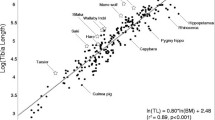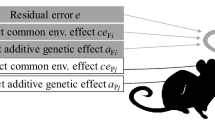Summary
-
1.
An experiment with mice is described which was intended to show whether the degree of sensitivity to environmental influences can be changed by selection of extreme phenotypic deviants for a metric character.
-
2.
Body weight was taken as a metric character and opposite extremes (large × small) were selected as parents in the “extreme” line. Individuals closest to the mean were selected as parents in the “central” line. The coefficient of variation of body weight was followed through 13 generations of this selection.
-
3.
No change of variability was detected in the extreme line. The males, but not the females, of the central line showed a small decline of variability.
-
4.
The two lines diverged in body weight in both sexes in the second half of the experiment, the extreme line being the heavier. The cause of this difference is not known.
-
5.
The conclusion to which the results point is that selection of extreme phenotypic deviants did not materially change the sensitivity to environmental influences. An increase in environmental variance from this cause is therefore unlikely to be an important consequence of unidirectional selection.
Similar content being viewed by others
Literature cited
Clayton, G., J. A. Morris andA. Robertson: Selection for abdominal chaetae in a large population ofDrosophila melanogaster. Symposium on Genetics of Population Structure. Internat. Union Biol. Sci., Naples., Ser. B, No15, 16–41 (1954).
Falconer, D. S.: Selection for large and small size in mice. J. Genet.51, 470–501 (1953).
Falconer, D. S., and J. W. B.King: A study of selection limits in the mouse. J. Genet.51, 561–581 (1953).
Grüneberg, H.: Variation within inbred strains of mice. Nature (Lond.)173, 674–676 (1954).
Haldane, J. B. S.: A mathematical theory of natural and artificial selection. Part VII. Selection intensity as a function of mortality rate. Proc. Cambridge Philos. Soc.27, 131–136 (1931).
MacArthur, J. W.: Selection for small and large body size in the house mouse. Genetics34, 194–209 (1949).
Mather, K.: Polygenic inheritance and natural selection. Biol. Rev.18, 32–64 (1943).
Moree, R.: An unexpected relation between negative assortative mating and gene frequency. Genetics38, 677–678 (1953).
Reeve, E. C. R., and F. W.Robertson: Analysis of environmental variability in quantitative inheritance. Nature (Lond.)171, 874 (1953).
Robertson, A.: The effect of selection against extreme deviants based on deviation or on homozygosis. J. Genet. (in press).
Robertson, F. W., and E. C. R.Reeve: Studies in quantitative inheritance. I. The effects of selection of wing and thorax length inDrosophila melanogaster. J. Genet.50, 414–448 (1952).
Author information
Authors and Affiliations
Additional information
With 2 figures in the text
Members of the Scientific Staff of the Agricultural Research Council.
Rights and permissions
About this article
Cite this article
Falconer, D.S., Robertson, A. Selection for environmental variability of body size in mice. Z.Ver-erbungslehre 87, 385–391 (1956). https://doi.org/10.1007/BF00737158
Received:
Issue Date:
DOI: https://doi.org/10.1007/BF00737158




